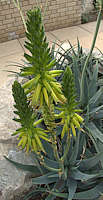  Families of Succulent Plants Families of Succulent Plants 
|
|
Monocotyledonsflowering plants with a single seed leaf |
Search this site
 |
|
|
|
| Succulent Plant Search EngineBotanical BookmarksBotanical GlossarySITEMAPEmail: webmaster |
|
The flowering plants (Magnoliophyta, angiosperms) can be divided into two groups, Monocotyledons and Dicotyledons.
Common although not invariable features among Monocotyledons are an irregular distribution of vascular bundles across the stem, leaves with parallel veins, flowers with parts in multiples of three and adventitious roots. Pollen usually has a single furrow running across the grain, and seeds have a single cotyledon. Most plant life styles are found among an estimated 50,000 - 60,000 species, including herbs, epiphytes, vines and trees. Modern molecular analysis has confirmed the coherence of most of the group. However, taxonomy within the Monocotyledons is frequently controversial and changes frequently.
|
 |




